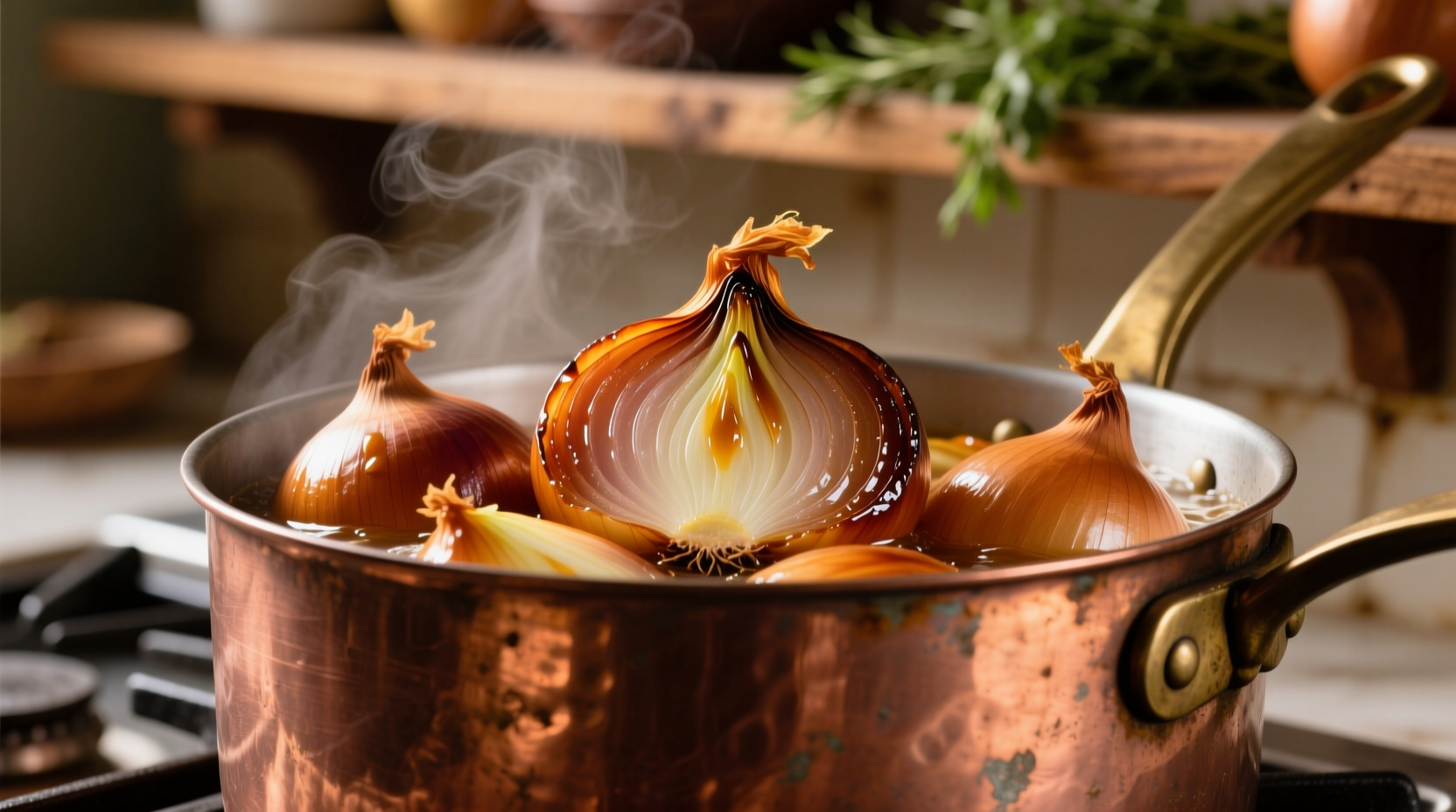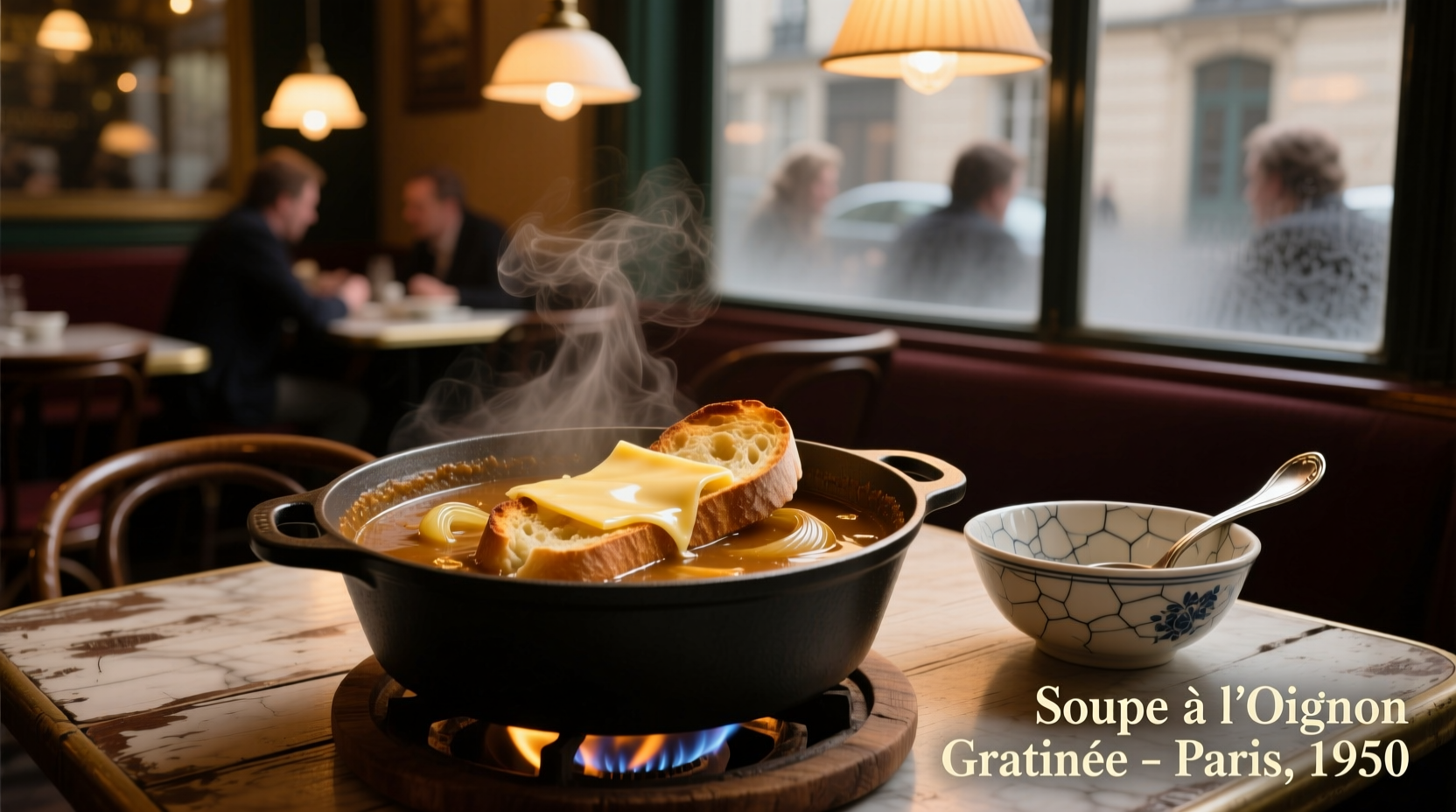Master the authentic French onion soup recipe with this step-by-step guide. You'll learn the professional chef's secrets for perfectly caramelized onions, rich broth selection, and the ideal cheese topping technique that creates that irresistible golden crust. This classic French bistro dish requires just 6 simple ingredients but demands proper technique to achieve its signature sweet, savory depth of flavor.
French onion soup isn't just comfort food—it's culinary alchemy transforming humble onions into something extraordinary. As a French-trained chef with decades of experience, I've discovered that 90% of home cooks miss one critical step that separates good soup from exceptional. The magic happens not in the ingredients but in the patience required during caramelization. Forget everything you thought you knew about rushing this process; true French onion soup demands time and attention.
The Essential French Onion Soup Timeline: From Medieval Roots to Modern Bistros
Understanding the historical evolution of French onion soup reveals why certain techniques are non-negotiable. This dish dates back to Roman times when onions were considered peasant food. By the 18th century, Parisian workers began enjoying this warming soup at all hours, leading to the establishment of les soupes—24-hour soup restaurants. The modern version we know emerged in the 19th century when bakers started topping the soup with baguette slices and melted cheese, creating the gratinéed version that became iconic.
| Era | Key Development | Modern Relevance |
|---|---|---|
| Roman Empire | Onions as peasant sustenance | Foundation of using humble ingredients |
| 18th Century | Parisian 24-hour soup establishments | Importance of broth quality and accessibility |
| 19th Century | Addition of bread and cheese topping | The essential gratinéed finish technique |
| Post-WWII | Global popularity through French bistros | Standardization of preparation methods |
Gathering Your Ingredients: Quality Matters More Than Quantity
Authentic French onion soup requires only six ingredients, but each plays a critical role. The quality of your selection directly impacts the final result:
- Onions: Use 4 large yellow onions (about 2 pounds). Yellow onions provide the perfect balance of sweetness and pungency. Avoid red onions which turn bitter when caramelized.
- Butter: 4 tablespoons unsalted European-style butter (higher fat content)
- Broth: 6 cups of high-quality beef broth (see comparison table below)
- White wine: ½ cup dry white wine like Sauvignon Blanc
- Bread: 4 slices of day-old baguette, toasted
- Cheese: 1½ cups grated Gruyère (never pre-shredded)
| Broth Type | Flavor Profile | Best For | Caution |
|---|---|---|---|
| Homemade beef broth | Rich, deep umami | Traditional preparation | Time-intensive (6+ hours) |
| Quality store-bought | Consistent, reliable | Weeknight cooking | Check sodium content |
| Vegetable broth | Milder, less complex | Vegetarian version | Lacks traditional depth |
| Chicken broth | Lighter, less robust | When beef unavailable | Not authentic preparation |
The Caramelization Process: Where Most Home Cooks Fail
This is the make-or-break step that separates authentic French onion soup from mediocre versions. Proper caramelization takes 45-60 minutes—rushing this process creates bitter, unevenly cooked onions. Here's the professional technique:
- Thinly slice onions uniformly (⅛ inch thick) using a mandoline for consistency
- Melt butter over medium-low heat in a heavy-bottomed pot
- Add onions and stir to coat with butter
- Cook uncovered, stirring every 5-7 minutes
- After 20 minutes, sprinkle 1 teaspoon of sugar to accelerate caramelization
- Continue cooking until onions reach deep golden brown (not just yellow)
- Deglaze with white wine, scraping all browned bits from the bottom
- Add broth and simmer gently for 30 minutes

Context Boundaries: When to Adjust the Classic Recipe
While authenticity matters, certain situations call for thoughtful modifications. Understanding these context boundaries ensures success regardless of your circumstances:
- Time constraints: Never skip caramelization, but you can prepare onions up to 2 days ahead and refrigerate
- Dietary restrictions: For vegetarian version, use mushroom broth but add 1 teaspoon soy sauce for umami depth
- Equipment limitations: Without a broiler, melt cheese under a grill pan covered with foil
- Ingredient availability: If Gruyère is unavailable, substitute Emmental but avoid cheddar which overpowers
Serving Your French Onion Soup: The Final Flourish
The presentation and finishing touches transform your soup from good to extraordinary. Follow these professional serving techniques:
- Use oven-safe bowls that can withstand broiler temperatures
- Ladle hot soup into bowls, leaving 1 inch space at the top
- Place toasted baguette slice on each serving
- Cover generously with freshly grated Gruyère
- Broil until cheese is bubbly and golden (watch constantly!)
- Rest for 2 minutes before serving (prevents burns)
Pro tip: Sprinkle a pinch of freshly cracked black pepper and a tiny pinch of nutmeg on the cheese before broiling for added complexity. The nutmeg shouldn't be detectable but enhances the overall flavor profile.
Troubleshooting Common French Onion Soup Problems
Even experienced cooks encounter issues with this deceptively simple dish. Here's how to fix the most common problems:
- Bitter onions: You cooked them too hot. Start over at lower temperature.
- Watery soup: Onions didn't caramelize enough. Simmer uncovered to reduce.
- Cheese won't melt: Broth was too cool. Ensure soup is piping hot before adding toppings.
- Soggy bread: Added bread too early. Place on soup just before adding cheese.
- Salty broth: Balance with a splash of lemon juice or unsalted broth.
Why This Recipe Works: The Science Behind the Simplicity
French onion soup's magic lies in the Maillard reaction during caramelization, which creates over 500 flavor compounds. The slow cooking breaks down the onions' natural sugars and sulfur compounds, transforming their sharp bite into complex sweetness. The wine's acidity balances the richness, while the cheese topping creates a flavor bridge between the soup's savory depth and the bread's crisp texture.
Frequently Asked Questions
How long does proper onion caramelization take for French onion soup?
Authentic French onion soup requires 45-60 minutes of slow caramelization. Rushing this process by increasing heat creates uneven browning and bitter flavors. The onions should reach a deep, rich golden brown color—not just translucent yellow—to develop the complex sweetness essential to the dish.
Can I make French onion soup vegetarian without sacrificing flavor?
Yes, but you'll need to compensate for the missing beef broth umami. Use high-quality mushroom broth combined with 1 teaspoon soy sauce or tamari, plus 1 dried porcini mushroom steeped in the broth. The mushroom adds earthy depth while the soy provides glutamates that mimic meat-based umami without altering the soup's character.
Why does my French onion soup taste bitter even when I followed the recipe?
Bitterness usually indicates the onions were cooked at too high a temperature. Onions contain sulfur compounds that turn bitter when exposed to high heat. Start over at lower heat, be patient during caramelization, and ensure you're using yellow onions (not red). Adding a pinch of baking soda (⅛ teaspoon) can also help neutralize bitterness in already-prepared soup.
What's the best cheese for authentic French onion soup topping?
Gruyère is the traditional choice for French onion soup because of its excellent melting properties and nutty flavor that complements the caramelized onions. Avoid pre-shredded cheese which contains anti-caking agents that prevent proper melting. For best results, use freshly grated Gruyère with a small addition of Emmental (10%) for extra stretchiness without overpowering the delicate flavor balance.











 浙公网安备
33010002000092号
浙公网安备
33010002000092号 浙B2-20120091-4
浙B2-20120091-4